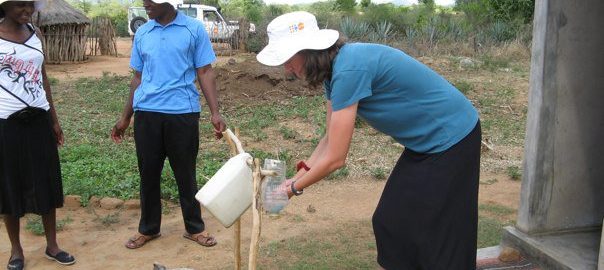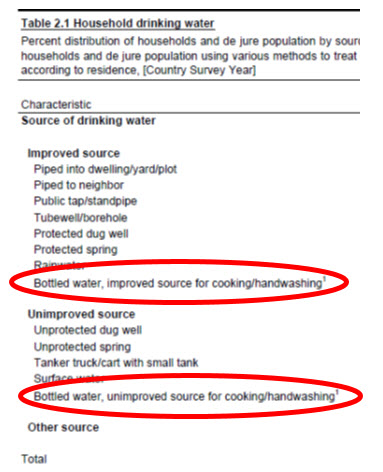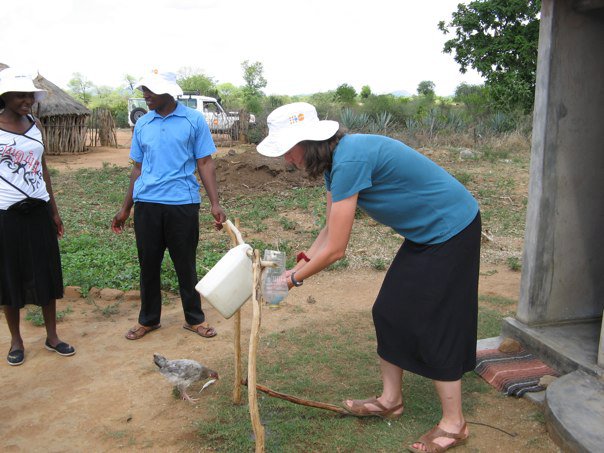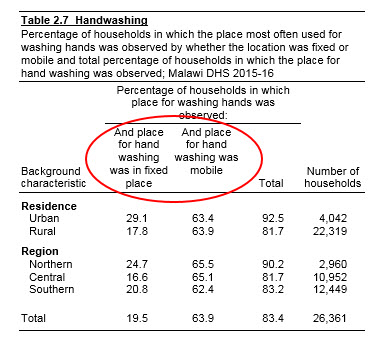New data available from DHS-7 Questionnaire: WASH Indicators

This is Part 2 in the New Data Available from DHS-7 Questionnaire blog series that explores the new data that are available in DHS reports resulting from changes made to the DHS-7 questionnaire in 2014. This post focuses on changes made to improve the quality and quantity of data collected about water and sanitation.
There has been increasing demand from the water, sanitation, and hygiene (WASH) community to gather more detailed information to measure the Sustainable Development Goal of access to water and sanitation for all. The major DHS-7 questionnaire enhancements in this area are outlined below.
Bottled water is now defined as an improved or unimproved source of drinking water depending on the source of water for cooking and handwashing. In the previous DHS-6 questionnaire, if a household indicated that the main source of drinking water for household members was bottled water, this was categorized as an improved source of drinking water. In the DHS-7 questionnaire (as in DHS-5), a household that uses bottled water for drinking is asked a follow-up question about the source of water used for cooking and handwashing (see questionnaire). For example, a household that uses bottled water for drinking but surface water (an unimproved source) for cooking and handwashing is considered to have an unimproved source. A household that uses bottled water for drinking and piped water (an improved source) for cooking and handwashing is considered to have an improved source. Both categories are listed in Table 2.1 (see figure).
 Why? This change was made to align DHS data with recommendations from the WHO/UNICEF Joint Monitoring Programme for Water Supply and Sanitation (JMP) which monitors progress towards Sustainable Development Goal 6: Ensure access to water and sanitation for all. It is important to note that while surveys like the DHS can assess the main source of household water, the source of water is only a proxy measure for quality. Sometimes water from an improved source is not safe to drink.
Why? This change was made to align DHS data with recommendations from the WHO/UNICEF Joint Monitoring Programme for Water Supply and Sanitation (JMP) which monitors progress towards Sustainable Development Goal 6: Ensure access to water and sanitation for all. It is important to note that while surveys like the DHS can assess the main source of household water, the source of water is only a proxy measure for quality. Sometimes water from an improved source is not safe to drink.
Implications: For most countries, this change will simply add insight into how households use water sources for different purposes. In countries where there is heavy reliance on bottled drinking water, reclassification of some of the bottled water users as having an unimproved water source may affect interpretation of trends in the larger “improved source” and “unimproved source” categories between surveys that include information about the source of water for cooking and handwashing and those that do not.
New category of improved source of drinking water added. Respondents to the household questionnaire can now indicate that their drinking water source is water piped to a neighbor.
Why? This response category was added because it is a common source of drinking water in some countries.
 New question and table on availability of water. For households using piped water or water from a borehole or tubewell, a new question has been added asking if water was available without an interruption of at least one day in the past 2 weeks (see Table 2. 2).
New question and table on availability of water. For households using piped water or water from a borehole or tubewell, a new question has been added asking if water was available without an interruption of at least one day in the past 2 weeks (see Table 2. 2).
Why? Scheduled or unscheduled interruptions in the water supply may force households to use unimproved sources. All persons should have sustainable access to adequate quantities of affordable and safe water. The new question helps determine whether or not households have a sustainable supply of water.
Implications: Water availability from some improved sources, such as piped water or tubewells, is not always consistent. Intermittent and unreliable water services result in inconvenience to water users and increased risk of compromised water safety.
 Sanitation and toilet facilities language clarified. The collection of data about toilet facilities has changed only marginally, however the language used to describe the different types of unimproved sanitation has been clarified. In DHS-7 reports, sanitation is divided into the categories seen in Table 2.3 from the 2015-16 Malawi DHS. Improved sanitation includes flush/pour systems, VIP latrines, and composting toilets, among others. Unimproved sanitation now includes three subcategories: a shared facility (this may still be a flush system, but by definition a shared facility is not improved); an unimproved facility, such as a pit latrine without a slab, an open pit latrine or a bucket; and open defecation, that is, the household has no facility and uses the field or bush.
Sanitation and toilet facilities language clarified. The collection of data about toilet facilities has changed only marginally, however the language used to describe the different types of unimproved sanitation has been clarified. In DHS-7 reports, sanitation is divided into the categories seen in Table 2.3 from the 2015-16 Malawi DHS. Improved sanitation includes flush/pour systems, VIP latrines, and composting toilets, among others. Unimproved sanitation now includes three subcategories: a shared facility (this may still be a flush system, but by definition a shared facility is not improved); an unimproved facility, such as a pit latrine without a slab, an open pit latrine or a bucket; and open defecation, that is, the household has no facility and uses the field or bush.
Why? Improved sanitation facilities are meant to separate human excreta from human contact. If an otherwise improved sanitation facility is shared with other households, the likelihood of exposure to fecal materials is increased.
Implications: In this case, the labeling of these categories is all that has changed. The DHS STATcompiler has been updated with new labels to reflect these categories. Interpretation of data for trend analysis is not affected.
New question added on location of toilet facilities. The DHS-7 questionnaire now also asks where the toilet facility is located. Table 2.3 categorizes these locations as “in own dwelling,” “in own yard/plot,” and “elsewhere.”
Why? If the sanitation facility used by the household is not in the dwelling or yard/plot, it is more difficult to access when needed, and it may pose a safety issue, especially for women and children.
Implications of this addition are not yet known; analysis of future survey data may provide insight.
Mobile sites for handwashing now captured. In previous surveys, interviewers asked household respondents to show them where members of the household usually wash their hands. The DHS-7 questionnaire allows for interviewers to indicate whether this handwashing site was fixed (such as a sink) or mobile (such as a pitcher or basin) (see Table 2.7 from the 2015-16 Malawi DHS).
Why? Many households without piped water do not have a fixed place for handwashing. In some countries (particularly in Africa), many households rely on mobile items for handwashing. When hands need to be washed, the individual may move a jug, basin, and soap from inside the home to the outdoor courtyard in order to wash hands. The ability to determine whether handwashing relies on a fixed or mobile place helps to interpret the handwashing data and to understand the physical and social norm-related barriers to handwashing with soap.
Implications: Early review of data from DHS-7 countries suggest that adding the mobile site for handwashing increases the percentage of households that will report that they have a handwashing site. Trends in this area should be interpreted with caution, as an increase in reported handwashing sites may be a function of the questionnaire change rather than a true change in handwashing practices.
Photo Caption: DHS Survey manager Joanna Lowell washes her hands in Zimbabwe during fieldwork in 2010.





sanitation and water crisis is happen every where. After defecate properly hand wash in mandatory.water crisis is all over the world and secondary source have the find for the water.